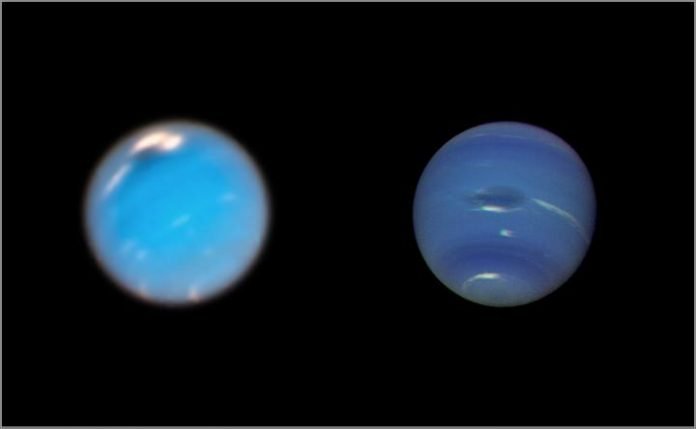
In the new study, researchers observed the formation of a Great Dark Spot on Neptune for the first time.
They used the Hubble Space Telescope to obtain valuable images.
The research was conducted by scientists from NASA’s Goddard Space Flight Center.
Previous research has shown that Neptune’s Great Dark Spots are storms that form from areas of high atmospheric pressure.
Researchers have found a total of six dark spots on Neptune over the years.
For example, Voyager 2 found two storms in 1989. Since Hubble launched in 1990, it has viewed four more of these storms.
In the new study, the scientists analyzed Hubble’s photos of the ice giant taken over the past several years.
They found a new Great Dark Spot appeared on Neptune in 2018. It was a smaller dark spot that appeared in 2015.
They also found the methane clouds were brightest in 2016 and 2017 before the new Great Dark Spot became visible.
The clouds may accompany the storms that form dark spots.
Their computer models of Neptune’s atmosphere showed the deeper the storm, the brighter its companion clouds.
Based on the findings, the researchers conclude dark spots formed much deeper in Neptune’s atmosphere than previously thought.
In addition, the Hubble images helped the researchers found how often Neptune gets dark spots and how long they last.
The researchers suggest the new findings offer insights on the inner workings of the poorly-understood ice giant planets.
They also are helpful in studying exoplanets of similar size and composition.
The team also suggests how Neptune’s Great Dark Spots differ from Jupiter’s Great Red Spot.
The Great Red Spot has been observed since at least 1830 and could be up to 350 years old.
The Neptunian winds operate in much wider bands around the planet, so storms like the Great Dark Spot slowly drift across latitudes.
The team plans to study changes in the shape of the vortex and wind speed in storms that form dark spots in the near future.
More frequent observations using the Hubble Telescope can help show clearly how storm systems on Neptune evolve.
The lead author of the study is Amy Simon, a planetary scientist at NASA’s Goddard Space Flight Center in Greenbelt, Maryland.
The study is published in the journal Geophysical Research Letters. A second study is published today in the Astronomical Journal.
Copyright © 2019 Knowridge Science Report. All rights reserved.



